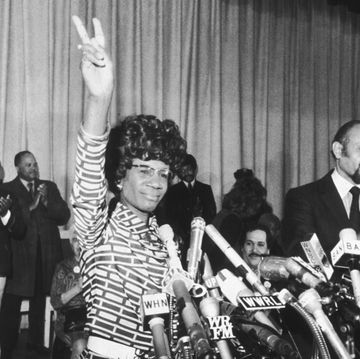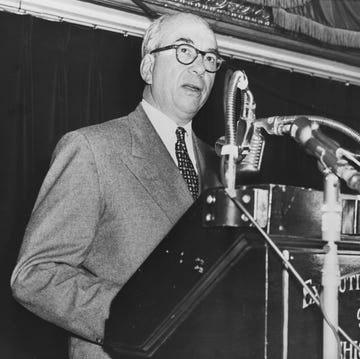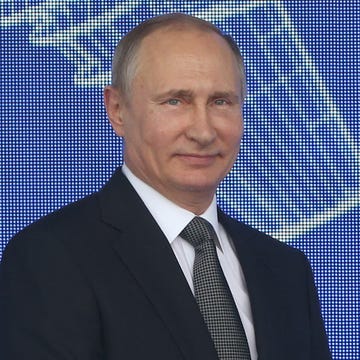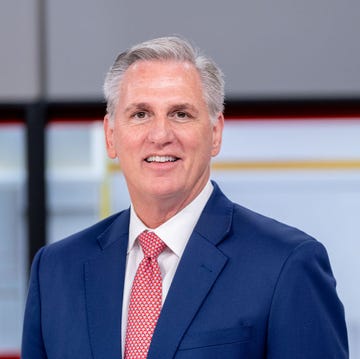(1870-1924)
Who Was Vladimir Lenin?
Vladimir Lenin founded the Russian Communist Party, led the Bolshevik Revolution and was the architect of the Soviet state. He was the posthumous source of "Leninism," the doctrine codified and conjoined with Marx's works by Lenin’s successors to form Marxism-Leninism, which became the Communist worldview. He has been regarded as the greatest revolutionary leader and thinker since Marx.
Early Years
Widely considered one of the most influential and controversial political figures of the 20th century, Vladimir Lenin engineered the Bolshevik revolution in Russia in 1917 and later took over as the first leader of the newly formed Union of Soviet Socialist Republics (USSR).
He was born Vladimir Ilich Ulyanov on April 22, 1870, in Simbirsk, Russia, which was later renamed Ulyanovsk in his honor. In 1901, he adopted the last name Lenin while doing underground party work. His family was well-educated, and Lenin, the third of six children, was close to his parents and siblings.
School was a central part of Lenin’s childhood. His parents, both educated and highly cultured, invoked a passion for learning in their children, especially Vladimir. A voracious reader, Lenin went on to finish first in his high school class, showing a particular gift for Latin and Greek.
But not all of life was easy for Lenin and his family. Two situations, in particular, shaped his life. The first came when Lenin was a boy and his father, an inspector of schools, was threatened with early retirement by a suspicious government nervous about the influence public school had on Russian society.
The more significant and more tragic situation came in 1887, when Lenin’s older brother, Aleksandr, a university student at the time, was arrested and executed for being a part of a group planning to assassinate Emperor Alexander III. With his father already dead, Lenin now became the man of the family.
Aleksandr’s involvement in oppositional politics was not an isolated incident in Lenin’s family. In fact, all of Lenin’s siblings would take part to some degree in revolutionary activities.
Young Revolutionary
The year of his brother’s execution, Lenin enrolled at Kazan University to study law. His time there was cut short, however, when, during his first term, he was expelled for taking part in a student demonstration.
Exiled to his grandfather’s estate in the village of Kokushkino, Lenin took up residence with his sister Anna, whom police had ordered to live there as a result of her own suspicious activities.
There, Lenin immersed himself in a host of radical literature, including the novel What Is To Be Done? by Nikolai Chernyshevsky, which tells the tale of a character named Rakhmetov, who carries a single-minded devotion to revolutionary politics. Lenin also soaked up the writing of Karl Marx, the German philosopher whose famous book Das Kapital would have a huge impact on Lenin’s thinking. In January 1889, Lenin declared himself a Marxist.
Eventually, Lenin received his law degree, finishing his schoolwork in 1892. He moved to the city of Samara, where his client base was largely composed of Russian peasants. Their struggles against what Lenin saw as a class-biased legal system only reinforced his Marxist beliefs.
In time, Lenin focused more of his energy on revolutionary politics. He left Samara in the mid-1890s for a new life in St. Petersburg, the Russian capital at the time. There, Lenin connected with other like-minded Marxists and began to take an increasingly active role in their activities.
The work did not go unnoticed, and in December 1895 Lenin and several other Marxist leaders were arrested. Lenin was exiled to Siberia for three years. His fiancée and future wife, Nadezhda Krupskaya, joined him.
Following his release from exile and then a stint in Munich, where Lenin and others co-founded a newspaper, Iskra, to unify Russian and European Marxists, he returned to St. Petersburg and stepped up his leadership role in the revolutionary movement.
At the Second Congress of the Russian Social Democratic Labor Party in 1903, a forceful Lenin argued for a streamlined party leadership community, one that would lead a network of lower party organizations and their workers. “Give us an organization of revolutionaries,” Lenin said, “and we will overturn Russia!”
The Revolution of 1905 and WWI
Lenin’s call was soon supported by events on the ground. In 1904 Russia went to war with Japan. The conflict had a profound impact on Russian society. After a number of defeats put a strain on the country’s domestic budget, citizens from all walks of life began to vocalize their discontent over the country’s political structure and called for reform.
The situation was heightened on January 9, 1905, when a group of unarmed workers in St. Petersburg took their concerns directly to the city’s palace to submit a petition to Emperor Nicholas II. They were met by security forces, who fired on the group, killing and wounding hundreds. The crisis set the stage for what would be called the Russian Revolution of 1905.
Hoping to placate his citizens, the emperor issued his October Manifesto, offering up several political concessions, most notably the creation of an elected legislative assembly known as the Duma.
But Lenin was far from satisfied. His frustrations extended to his fellow Marxists, in particular, the group calling itself the Mensheviks, led by Julius Martov. The issues centered around party structure and the driving forces of a revolution to fully seize control of Russia. While his comrades believed that the power must reside with the bourgeoisie, Lenin passionately distrusted that segment of the population. Instead, he argued, a real and complete revolution, one that could lead to the Socialist Revolution that could spread outside of Russia, must be led by the workers, the country’s proletariat.
From the Mensheviks’ point of view, however, Lenin’s ideas really paved the way for a one-man dictatorship over the people he claimed he wanted to empower. The two groups had sparred since party’s Second Congress, which had handed Lenin’s group, known as the Bolsheviks, a slim majority. The fighting would continue until a 1912 party conference in Prague, when Lenin formally split to create a new, separate entity.
During World War I Lenin went into exile again, this time taking up residence in Switzerland. As always, his mind stayed focus on revolutionary politics. During this period he wrote and published Imperialism, The Highest Stage of Capitalism (1916), a defining work for the future leader, in which he argued that war was the natural result of international capitalism.
Russian Leader
In 1917, a tired, hungry and war-weary Russia deposed the tsars. Lenin quickly returned home and, perhaps sensing his own path to power, quickly denounced the country’s newly formed Provisional Government, which had been assembled by a group of leaders of the bourgeois liberal parties. Lenin instead called for a Soviet government, one that would be ruled directly by soldiers, peasants and workers.
In late 1917 Lenin led what was soon to be known as the October Revolution, but was essentially a coup d’état. Three years of civil war followed. The Lenin-led Soviet government faced incredible odds. The anti-Soviet forces headed mainly by former tsarist generals and admirals, fought desperately to overthrow Lenin’s Red regime. They were aided by World War I Allies, who supplied the group with money and troops.
Determined to win at any cost, Lenin showed himself to be ruthless in his push to secure power. He launched what came to be known as the Red Terror, a vicious campaign Lenin used to eliminate the opposition within the civilian population.
In August 1918 Lenin narrowly escaped an assassination attempt, when he was severely wounded with a pair of bullets from a political opponent. His recovery only reinforced his larger-than-life presence among his countrymen, though his health was never truly the same.
Despite the breadth of the opposition, Lenin came out victorious. But the kind of country he hoped to lead never came to fruition. His defeat of an opposition that wished to keep Russia tethered to Europe’s capitalist system, ushered in an era of international retreat for the Lenin-led government. Russia, as he saw it, would be void of class conflict and the international wars it fostered.
But the Russia he presided over was reeling from the bloody civil war he’d helped instigate. Famine and poverty shaped much of society. In 1921, Lenin now faced the same kind of peasant uprising he’d ridden to power. Widespread strikes in cities and in rural sections of the country broke out, threatening the stability of Lenin’s government.
To ease the tension, Lenin introduced the New Economic Policy, which allowed workers to sell their grain on the open market.
Later Years and Death
Lenin suffered a stroke in May 1922, and then a second one in December of that year. With his health in obvious decline, Lenin turned his thoughts to how the newly formed USSR would be governed after he was gone.
Increasingly, he saw a party and government that had strayed far from its revolutionary goals. In early 1923 he issued what came to be called as his Testament, in which a regretful Lenin expressed remorse over the dictatorial power that dominated Soviet government. He was particularly disappointed with Joseph Stalin, the general secretary of the Communist Party, who had begun to amass great power.
On March 10, 1923, Lenin’s health was dealt another severe blow when he suffered an additional stroke, this one taking away his ability to speak and concluding his political work. Nearly 10 months later, on January 21, 1924, he passed away in the village now known as Gorki Leninskiye. In a testament to his standing in Russian society, his corpse was embalmed and placed in a mausoleum on Moscow’s Red Square.
Watch "Vladimir Lenin: Voice of Revolution" on HISTORY Vault
QUICK FACTS
- Name: Vladimir Lenin
- Birth Year: 1870
- Birth date: April 22, 1870
- Birth City: Simbirsk
- Birth Country: Russia
- Gender: Male
- Best Known For: Vladimir Lenin was founder of the Russian Communist Party, leader of the Bolshevik Revolution and architect and first head of the Soviet state.
- Industries
- World Politics
- Journalism and Nonfiction
- Astrological Sign: Taurus
- Schools
- Kazan University
- Death Year: 1924
- Death date: January 21, 1924
- Death City: Gorki
- Death Country: Russia
Fact Check
We strive for accuracy and fairness.If you see something that doesn't look right,contact us!
CITATION INFORMATION
- Article Title: Vladimir Lenin Biography
- Author: Biography.com Editors
- Website Name: The Biography.com website
- Url: https://www.biography.com/political-figures/vladimir-lenin
- Access Date:
- Publisher: A&E; Television Networks
- Last Updated: May 7, 2021
- Original Published Date: April 3, 2014













